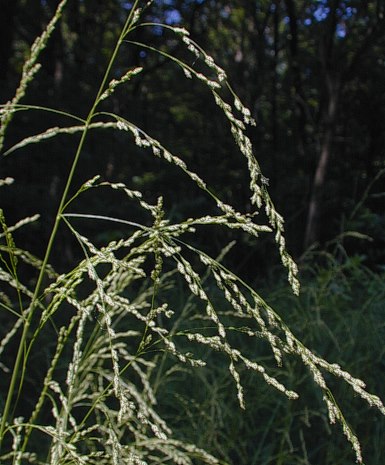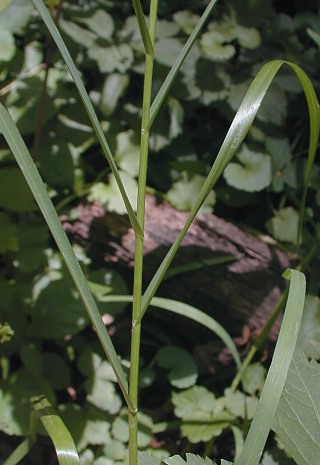Description: This perennial grass is 2–3½' tall, forming tufts of unbranched culms that are erect to ascending. Each culm is light to medium green, terete, and glabrous; there are about 6 alternate leaves along its length. The leaf blades are up to 12" long and 7 mm. across, ascending to widely spreading, and flat or slightly curved. Each leaf blade is medium green to grayish blue and slightly rough on the upper surface, while its lower surface is medium green, glabrous, and smooth. The leaf sheaths are medium green, finely veined, and hairless. The ligules are white-membranous.

Each culm
terminates in an airy panicle of spikelets up to 12" long and half as
much across; it is usually pyramidal in shape with the longer branches
toward the bottom (up to 5" long). When the culm is not erect, the
branches of the entire inflorescence may lean toward one side. These
branches are slender and rough; they are ascending to spreading near
the central axis of the inflorescence, otherwise they have a tendency
to droop downward. The branches occur in whorls of 2-4 along the
central axis, where they are largely naked. Individual spikelets occur
at the tips of the terminal branchlets. Each spikelet is pale green to
pale purple and about 3-4 mm. long; it has 3-7 lemmas in two ranks and
a pair of glumes at the bottom. The tiny glumes are 0.5–1.0 mm. in
length, ovate to lanceolate-ovate, and single-veined. The lemmas are
1.25–2.0 mm. in length, oblong-ovate, and gently curved; each lemma has
7 prominent veins and its margins become white-membranous toward the
apex. There is no tuft of hairs at the base of each lemma. The blooming
period occurs from early to mid-summer. Afterwards, the spikelets
become greenish yellow and finally light tan when their small grains
have matured; disarticulation is above the the glumes. The root system
is fibrous. This grass spreads by reseeding itself and occasionally
forms colonies.

Cultivation:
The preference is full sun to light shade, wet to mesic conditions, and
a fertile loamy soil. This grass requires more moisture in sunny areas
than when it is growing in the shade. Most vegetative growth occurs
during the spring and early summer.
Range & Habitat:
The native Fowl Manna Grass occurs in every county of Illinois and it
is quite common
(see Distribution
Map). Habitats include wet to mesic deciduous woodlands,
swamps, damp meadows in wooded areas, prairie swales, marshes and fens,
sandy and gravelly seeps, bogs, and ditches. This common grass can be
found in either woodlands or wetlands of varying quality.
Faunal Associations:
Fowl Manna Grass is the preferred host plant of a moth, Elachista
irrorata. The larvae of this moth are leaf-miners (Braun,
1948). Several aphids are known to use Manna Grasses (Glyceria
spp.) primarily as summer host plants, including Carolinia
howardii, Metopolophium dirhodum
(Rose-Grass Aphid), Rhopalomyzus poae, Rhopalosiphum
oxyacanthae (Apple-Grass Aphid), and Sipha glyceriae;
see Blackman & Eastop (2013) and Pepper (1965). The foliage is
palatable to cattle, sheep, and horses, but it is
largely ignored by White-tailed Deer. In spite of the common name, Fowl
Manna Grass isn't an important food source for ducks, although Canada
Geese will eat the foliage when this species occurs along bodies of
water. Because this grass is fairly tall and occasionally forms
colonies, it provides some cover for wildlife.
Photographic Location:
A powerline clearance at Busey Woods in Urbana, Illinois, and a moist
area of the same woodlands.
Comments:
Because it has a rather ordinary appearance and its spikelets are
small, this grass doesn't draw much attention to itself. It
superficially resembles an oversized bluegrass (Poa sp.),
but its lemmas lack the tufts of hair that are typical of most
bluegrass species. Perhaps the most striking characteristic is the
droopiness of the inflorescence. The common name may refer to the use
of a Glyceria sp. in Europe as a source of food for
domesticated geese. Fowl Manna Grass is the most common Glyceria
sp. in Illinois. It can be distinguished from other species
in this genus by the small size of its spikelets and lemmas. Other Glyceria
spp. are largely restricted to the northern section of the
state; they have spikelets that exceed 5 mm. in length and lemmas that
exceed 2.0 mm. in length. Some of these species also differ in having
lemmas with less prominent veins, and they often bloom later in the
year than Fowl Manna Grass.